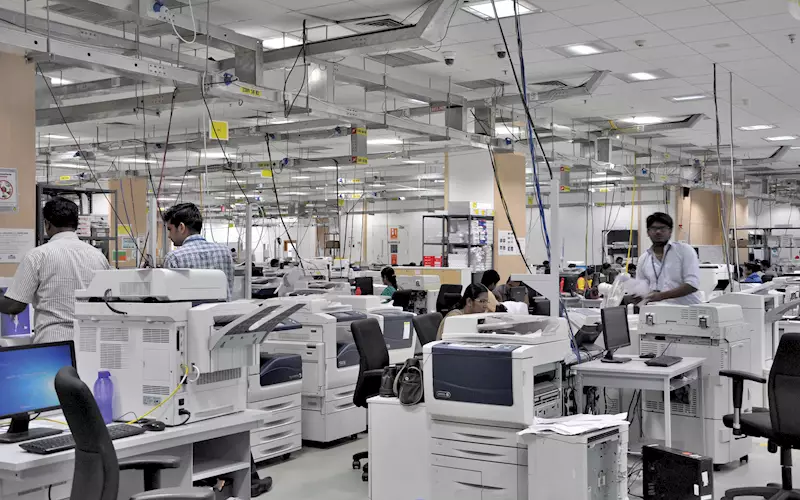Ramu Ramanathan travels to Chennai to investigate the operations in the southern megapolis, which forms the research backbone for Xerox’s 108 models, right from WC5945 / 55 to iGens to the 1000s. A lot of research by the USD 19.5 billion digital giant is powered by XRCI in Bengaluru and the HCL facility in Chennai. HCL, with a small team from Xerox, work on the 20,000 devices. Rajagopalan Balaji, executive director – technology and channels, Xerox India, plays Virgil t
 Ramu Ramanathan (RR): Congratulations. This is mind-boggling. 108 models. 20,000 devices. 1000 scientists. What was the objective of the centre at Chennai?
Ramu Ramanathan (RR): Congratulations. This is mind-boggling. 108 models. 20,000 devices. 1000 scientists. What was the objective of the centre at Chennai?Rajagopalan Balaji (RB): The objective of setting up a centre in Chennai was to create a leading product development centre in India that offered high-quality technology resources at a competitive cost. We chose Chennai because it needed it to be close to a sea-port to optimise the logistics costs.
Chennai fit the bill, perfectly. We had the right partner in HCL to put this in place. This allowed for collaboration that brought the best of the two worlds together. This is Xerox from the R&D prowess and HCL from a software perspective.
RR: Describe the early heady days?
RB: It is important to understand that plans evolve over a period of time. We saw the opportunity. We did our research. Slowly, we progressed towards making it happen. Later, we mastered the process and managed things, effectively.
RR: What is the key to enter a market that seeks digital?
RB: There has to be a product at the forefront of development. The key from the R&D point of view is, to see if that product is actually required in the marketplace. And then, how best can you cater to the specific requirements in the market.
RR: In terms of cost and development, the Xerox team seems to have achieved both. Correct?
RB: Quite true. Our setup in Chennai is completely focused on the technology space, for which we have tied up with HCL. The entire objective of this tie-up is to take inputs from customers, especially from the developing countries and enable the technology, at the development stage.
RR: So Xerox can have a product which can co-exist with the requirement of the developed and developing worlds?
RB: We are talking about having a product which can co-exist and meet the requirements of both developed and developing markets. Apart from this, it also enables us to be cost-efficient and take advantage of the huge talent pool in India.
Our products are feature rich. Customers who use these products, can operate right away and concentrate on what matters most – real business. If you look at our recently launched products such as the Xerox C60/C70, they come bundled with exciting features and great technology. This means, we can replicate tech specs from top products into the entry production colour press and deliver a great output and print quality.
RR: The interesting aspect is the use of digital front-end. Tell us about that?
RB: Normally, we see machines with a digital front-end with Fiery etc. We have developed FFPS (The Freeflow Print Server) in the Chennai centre. This enables printers to use the Windows platform in FFPS which otherwise was a Solaris platform. As you know, Solaris is a complex front-end platform and is difficult for people to use. As you can know, FFPS is not complex but a very user-friendly platform.
RR: Describe this transition to the Windows platform. How much work has gone into it and how has the Windows platform become part of the long-term strategy?
RB: Firstly, I would like to highlight that this transition was enabled by the Chennai centre in India. A lot of work has gone into making this smooth transition in a short time span. The idea behind this was to be on the winning side, both from the customer point of view and the people who interfaced with the customer. To enable this, we took regular feedback from customers to make our devices more cost-effective while delivering the same quality output.
India is a very price-sensitive yet demanding market, customers want low-cost solutions without compromising on quality and output.
RR: So this was the objective?
RB: Yes, and with this in mind, we took regular feedback from our customers, pre-sales and sales team. With all this feedback handy, we did regular monthly communication meetings with the R&D team. We worked together to explore and analyse the positives and the negatives of the market. We were hence able to cross collaborate both virtually and physically.
RR: As a result, you came up with a new digital manifesto?
RB: Absolutely. The prime ask from our R&D team was, can all the ideas be implemented? And if implemented, was there a market opportunity? We gave them the confidence that there is an immense opportunity if we could implement our ideas. The FFPS Windows is a classic example of bringing all the top brains and minds together to address a market requirement and tap the opportunity.
RR: Another thing at the R&D Centre is the simulations...
RB: One can perform innumerable simulations at the R&D Centre but the most important simulation is actual information generation by going to the environment of the user. So we did a lot of workshops and took our design team into the market and got them to talk to the customers as that helped them get a good first-hand perspective on what the customer needed.
 Ramu Ramanathan (RR): Congratulations. This is mind-boggling. 108 models. 20,000 devices. 1000 scientists. What was the objective of the centre at Chennai?
Ramu Ramanathan (RR): Congratulations. This is mind-boggling. 108 models. 20,000 devices. 1000 scientists. What was the objective of the centre at Chennai?










 See All
See All